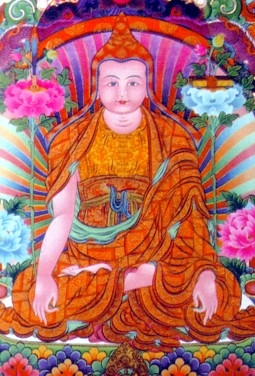Longchenpa: Difference between revisions
Jump to navigation
Jump to search
No edit summary |
No edit summary |
||
| Line 6: | Line 6: | ||
:The figure of Longchen Rabjam (1308–1363) stands out as one of the greatest Dzogchen masters in the Nyingma tradition, and amongst the most brilliant and original writers in Tibetan Buddhist literature. He was the author of over 200 works, of which only about twenty-five survive, and amongst which the [[Seven Treasuries]] (''Dzö Dun'') and Three Trilogies are most well-known. It was he who brought together into a cohesive system the teachings of [[Vima Nyingtik]] and [[Khandro Nyingtik]], on which he wrote the ‘Three Yangtik’ or Inner Essencess. | :The figure of Longchen Rabjam (1308–1363) stands out as one of the greatest Dzogchen masters in the Nyingma tradition, and amongst the most brilliant and original writers in Tibetan Buddhist literature. He was the author of over 200 works, of which only about twenty-five survive, and amongst which the [[Seven Treasuries]] (''Dzö Dun'') and Three Trilogies are most well-known. It was he who brought together into a cohesive system the teachings of [[Vima Nyingtik]] and [[Khandro Nyingtik]], on which he wrote the ‘Three Yangtik’ or Inner Essencess. | ||
:As [[Nyoshul Khen Rinpoche]] explains: “Kunkhyen Longchenpa’s Seven Treasuries (Dzö Dun) were written to elucidate the extraordinarily profound meaning of the seventeen main Tantras of Dzogpachenpo as well as the teachings of all [[Nine Yanas]]. For the purpose of the actual practice of Dzogchen according to these Tantras, Longchenpa gathered his own [[terma]]s as well as those of [[Chetsün Senge Wangchuk]] (who was later reborn as [[Jamyang Khyentse Wangpo]]) and Pema Ledrel Tsal (Longchenpa’s previous incarnation) in the form of the thirteen volume collection known as the [[Nyingtik Yabshyi]]. This Yabshyi is the practice aspect of Longchenpa’s writings, and the basis of the Old Nyingtik. In it he synthesized the Vima Nyingtik of [[Vimalamitra]] and the Khandro Nyingtik of [[Guru Rinpoche]] and explained all the practical details in the light of his own realization.” | :As [[Nyoshul Khen Rinpoche]] explains: “Kunkhyen Longchenpa’s Seven Treasuries (Dzö Dun) were written to elucidate the extraordinarily profound meaning of the seventeen main Tantras of Dzogpachenpo as well as the teachings of all [[Nine Yanas]]. For the purpose of the actual practice of Dzogchen according to these Tantras, Longchenpa gathered his own [[terma]]s as well as those of [[Chetsün Senge Wangchuk]] (who was later reborn as [[Jamyang Khyentse Wangpo]]) and Pema Ledrel Tsal (Longchenpa’s previous incarnation) in the form of the thirteen volume collection known as the [[Nyingtik Yabshyi]]. This Yabshyi is the practice aspect of Longchenpa’s writings, and the basis of the Old Nyingtik. In it he synthesized the Vima Nyingtik of [[Vimalamitra]] and the Khandro Nyingtik of [[Guru Rinpoche]] and explained all the practical details in the light of his own realization.”<ref>''Dzogchen and Padmasambhava''</ref> | ||
===His Writings=== | ===His Writings=== | ||
| Line 12: | Line 12: | ||
*[[Trilogy of Finding Comfort and Ease]] | *[[Trilogy of Finding Comfort and Ease]] | ||
== | ===Notes=== | ||
<references/> | |||
==Further Reading== | ==Further Reading== | ||
Revision as of 11:06, 25 June 2007

Longchenpa - (1308-1363), also known as Longchen Rabjam, ‘Infinite, Vast Expanse of Space’, was one of the most brilliant teachers of the Nyingma lineage. He systematized the Nyingma teachings in his ‘Seven Treasures’ and wrote extensively on Dzogchen. He transmitted the Longchen Nyingtik [Tib.] cycle of teachings and practice to Jikmé Lingpa, and it has since become one of the most widely practised of traditions.
Sogyal Rinpoche writes:
- The figure of Longchen Rabjam (1308–1363) stands out as one of the greatest Dzogchen masters in the Nyingma tradition, and amongst the most brilliant and original writers in Tibetan Buddhist literature. He was the author of over 200 works, of which only about twenty-five survive, and amongst which the Seven Treasuries (Dzö Dun) and Three Trilogies are most well-known. It was he who brought together into a cohesive system the teachings of Vima Nyingtik and Khandro Nyingtik, on which he wrote the ‘Three Yangtik’ or Inner Essencess.
- As Nyoshul Khen Rinpoche explains: “Kunkhyen Longchenpa’s Seven Treasuries (Dzö Dun) were written to elucidate the extraordinarily profound meaning of the seventeen main Tantras of Dzogpachenpo as well as the teachings of all Nine Yanas. For the purpose of the actual practice of Dzogchen according to these Tantras, Longchenpa gathered his own termas as well as those of Chetsün Senge Wangchuk (who was later reborn as Jamyang Khyentse Wangpo) and Pema Ledrel Tsal (Longchenpa’s previous incarnation) in the form of the thirteen volume collection known as the Nyingtik Yabshyi. This Yabshyi is the practice aspect of Longchenpa’s writings, and the basis of the Old Nyingtik. In it he synthesized the Vima Nyingtik of Vimalamitra and the Khandro Nyingtik of Guru Rinpoche and explained all the practical details in the light of his own realization.”[1]
His Writings
Notes
- ↑ Dzogchen and Padmasambhava
Further Reading
- For a short biography, see Masters of Meditation and Miracles, pages 109-117.